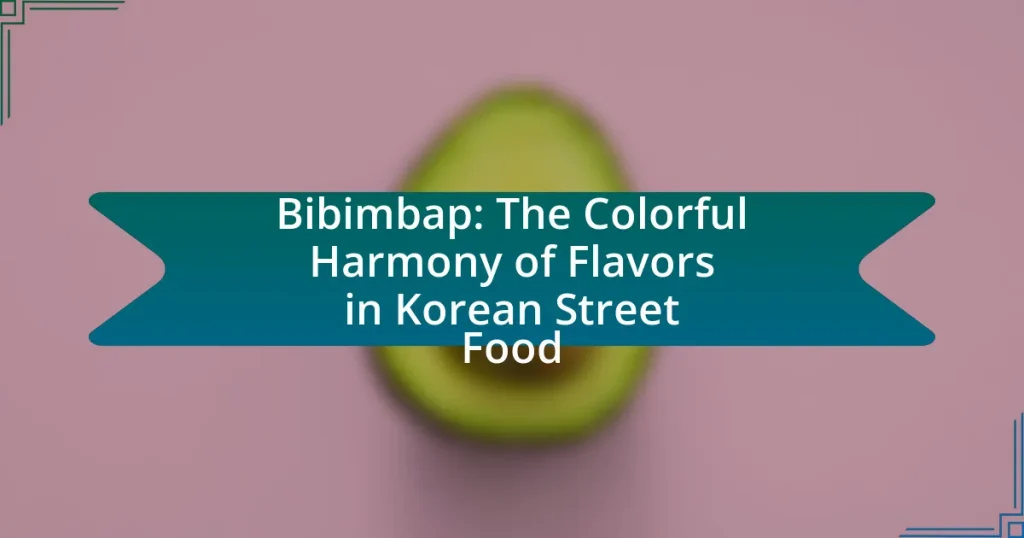Bibimbap is a traditional Korean dish characterized by a bowl of rice topped with assorted vegetables, meat, and often a fried egg, all mixed with gochujang, a Korean chili paste. Originating in the late 19th century, bibimbap reflects the Korean philosophy of balance and nutrition, evolving from a farmer’s meal to a culturally significant dish served at royal banquets. The article explores the historical roots, key ingredients, nutritional benefits, regional variations, and the cultural significance of bibimbap, highlighting its role in Korean street food culture and its adaptability in international cuisine. Additionally, it provides tips for recreating authentic bibimbap flavors at home while avoiding common mistakes.

What is Bibimbap?
Bibimbap is a traditional Korean dish that consists of a bowl of rice topped with a variety of vegetables, meat, and often a fried egg, all mixed together with gochujang (Korean chili paste). This dish is characterized by its vibrant colors and diverse flavors, reflecting the harmony of ingredients used. Bibimbap has historical roots dating back to the late 19th century, where it was originally served as a royal dish, showcasing the importance of balance and nutrition in Korean cuisine.
How did Bibimbap originate in Korean cuisine?
Bibimbap originated in Korean cuisine as a traditional mixed rice dish that dates back to the late 19th century. Initially, it was a meal for farmers, designed to utilize leftover ingredients and promote a balanced diet. The dish gained popularity in the early 20th century, particularly in urban areas, as it represented a harmonious blend of various vegetables, meats, and gochujang (red chili paste), reflecting the Korean philosophy of balance and health in food. Historical records indicate that bibimbap was served during royal banquets, further solidifying its status in Korean culinary culture.
What historical events influenced the creation of Bibimbap?
Bibimbap was influenced by historical events such as the agricultural advancements during the Goryeo Dynasty (918-1392) and the subsequent unification of Korea under the Joseon Dynasty (1392-1910). These periods saw an increase in rice cultivation and the introduction of various vegetables, which contributed to the dish’s diverse ingredients. Additionally, the influence of Confucianism during the Joseon Dynasty emphasized harmony and balance in meals, further shaping the concept of bibimbap as a dish that combines multiple flavors and textures in a single bowl.
How has Bibimbap evolved over time?
Bibimbap has evolved from a simple mixed rice dish into a complex and culturally significant meal in Korean cuisine. Originally, bibimbap was a farmer’s meal, combining leftover vegetables and rice, but over time, it has incorporated a variety of ingredients, including meats, eggs, and diverse vegetables, reflecting regional variations and seasonal availability. The dish gained prominence during the Joseon Dynasty, where it was served in royal courts, showcasing its transformation into a symbol of Korean culinary art. Today, bibimbap is recognized globally, often served in modern interpretations that emphasize health and presentation, such as the use of organic ingredients and artistic plating, further solidifying its status as a staple of Korean street food.
What are the key ingredients in Bibimbap?
The key ingredients in Bibimbap include rice, assorted vegetables, a protein source (typically beef or tofu), a fried egg, and gochujang (Korean chili paste). Rice serves as the base, while vegetables such as spinach, carrots, and bean sprouts provide color and nutrition. The protein adds substance, and the fried egg contributes richness, with gochujang offering a spicy kick that enhances the dish’s overall flavor profile. Bibimbap is known for its vibrant presentation and balanced combination of textures and tastes, making it a staple in Korean cuisine.
What vegetables are commonly used in Bibimbap?
Bibimbap commonly includes a variety of vegetables such as spinach, bean sprouts, carrots, zucchini, and mushrooms. These vegetables are typically sautéed or blanched and arranged beautifully on top of rice, contributing to the dish’s vibrant colors and textures. The use of these specific vegetables is rooted in traditional Korean cuisine, where seasonal and fresh ingredients are emphasized, enhancing both the nutritional value and flavor profile of the dish.
How does the choice of protein affect the flavor of Bibimbap?
The choice of protein significantly influences the flavor profile of Bibimbap. Different proteins, such as beef, chicken, or tofu, impart distinct tastes and textures that enhance the overall dish. For instance, beef, often marinated in a mixture of soy sauce, sugar, and sesame oil, adds a savory umami flavor, while chicken provides a milder taste that allows the vegetables and sauces to shine. Tofu, being plant-based, contributes a subtle nuttiness and absorbs the flavors of the accompanying ingredients. This variety in protein not only affects the taste but also the nutritional content, making Bibimbap versatile and appealing to a wide range of dietary preferences.
Why is Bibimbap considered a balanced meal?
Bibimbap is considered a balanced meal because it incorporates a variety of food groups, providing essential nutrients. This Korean dish typically includes rice, assorted vegetables, protein (such as beef or tofu), and a fried egg, which together offer carbohydrates, vitamins, minerals, and protein. The inclusion of multiple vegetables ensures a range of vitamins and dietary fiber, while the protein source contributes to muscle repair and overall health. Additionally, the dish is often topped with gochujang, a fermented chili paste, which adds flavor and probiotics, further enhancing its nutritional profile.
What nutritional benefits does Bibimbap provide?
Bibimbap provides a variety of nutritional benefits, including a balanced mix of macronutrients and micronutrients. This Korean dish typically contains rice, assorted vegetables, protein (such as beef or tofu), and a fried egg, contributing to a well-rounded meal. The vegetables offer vitamins A, C, and K, while the protein source provides essential amino acids. Additionally, the dish is often topped with gochujang, a fermented chili paste that can enhance gut health due to its probiotic content. The combination of these ingredients supports overall health by promoting energy, muscle repair, and digestive health.
How does the combination of ingredients contribute to its healthiness?
The combination of ingredients in bibimbap contributes to its healthiness by providing a balanced mix of macronutrients, vitamins, and minerals. Bibimbap typically includes a variety of vegetables, which are rich in dietary fiber and antioxidants, promoting digestive health and reducing inflammation. The inclusion of protein sources such as beef or tofu supports muscle maintenance and repair, while the presence of rice offers complex carbohydrates for sustained energy. Additionally, the use of sesame oil and gochujang adds healthy fats and flavor without excessive calories. Studies show that diets rich in vegetables and lean proteins can lower the risk of chronic diseases, reinforcing the health benefits of bibimbap’s diverse ingredients.

What are the different variations of Bibimbap?
Bibimbap has several variations, each distinguished by its ingredients and regional influences. Common variations include Jeonju Bibimbap, known for its rich assortment of vegetables and beef, and Dolsot Bibimbap, which is served in a hot stone bowl that creates a crispy rice layer. Other notable types are Yangnyeom Bibimbap, which features marinated vegetables, and Hae-mul Bibimbap, incorporating seafood. These variations reflect the diverse culinary practices across Korea, showcasing local ingredients and preferences.
How do regional differences influence Bibimbap recipes?
Regional differences significantly influence Bibimbap recipes by altering the choice of ingredients and preparation methods based on local agricultural products and culinary traditions. For instance, in Jeonju, known as the birthplace of Bibimbap, the dish features a variety of locally sourced vegetables and high-quality beef, reflecting the region’s agricultural richness. In contrast, coastal areas like Busan may incorporate seafood, such as raw fish or shellfish, showcasing the availability of fresh marine ingredients. Additionally, variations in seasoning, such as the use of different types of gochujang (red chili paste) or sesame oil, further highlight regional preferences and flavors, making each Bibimbap unique to its locale.
What are some popular regional variations of Bibimbap in Korea?
Some popular regional variations of Bibimbap in Korea include Jeonju Bibimbap, known for its use of high-quality ingredients and a rich variety of vegetables; Dongnae Bibimbap, which features a unique combination of seafood and vegetables; and Sunchang Bibimbap, recognized for its spicy gochujang sauce. Each variation reflects local ingredients and culinary traditions, enhancing the overall diversity of this iconic dish. For instance, Jeonju Bibimbap is often served with a raw egg yolk and is considered a UNESCO-recognized dish, highlighting its cultural significance.
How do international adaptations of Bibimbap differ from traditional recipes?
International adaptations of Bibimbap often differ from traditional recipes by incorporating local ingredients and flavors, which can alter the dish’s authenticity. For instance, while traditional Bibimbap features a base of rice topped with a variety of seasoned vegetables, a fried egg, and gochujang (Korean chili paste), international versions may substitute these elements with locally popular vegetables, proteins like chicken or tofu, and alternative sauces such as teriyaki or sriracha. This reflects a fusion approach, where the essence of Bibimbap is maintained but modified to suit regional tastes and dietary preferences, leading to variations that may not adhere to the original Korean culinary techniques or flavor profiles.
What are the common serving styles for Bibimbap?
Bibimbap is commonly served in two styles: in a hot stone bowl, known as dolsot bibimbap, and in a regular bowl, referred to as bibimbap. Dolsot bibimbap features a sizzling stone bowl that keeps the ingredients warm and creates a crispy rice layer at the bottom, while regular bibimbap is served in a standard bowl without the heat element. Both styles typically include a mix of rice, vegetables, meat, and a spicy sauce, showcasing the dish’s vibrant colors and flavors.
How is Bibimbap typically presented in restaurants?
Bibimbap is typically presented in restaurants in a visually appealing manner, often served in a hot stone bowl called dolsot. This presentation allows the ingredients, which include rice, assorted vegetables, meat, and a fried egg, to be arranged artfully on top of the rice, creating a colorful and vibrant dish. The use of the hot stone bowl not only enhances the visual appeal but also keeps the dish warm and allows the bottom layer of rice to become crispy. This traditional serving style emphasizes the harmony of flavors and textures that bibimbap is known for, making it a signature dish in Korean cuisine.
What role does the serving vessel play in the Bibimbap experience?
The serving vessel plays a crucial role in the Bibimbap experience by enhancing the dish’s presentation and maintaining its temperature. Traditionally, Bibimbap is served in a hot stone bowl called dolsot, which not only keeps the ingredients warm but also creates a crispy layer of rice at the bottom. This unique cooking method allows diners to enjoy a combination of textures and flavors, as the heat from the vessel continues to cook the ingredients even after being served. The visual appeal of the vibrant colors in the bowl also contributes to the overall dining experience, making it not just a meal but an artful presentation of Korean culinary tradition.

How is Bibimbap enjoyed in Korean street food culture?
Bibimbap is enjoyed in Korean street food culture as a vibrant and customizable dish that reflects the diversity of ingredients and flavors found in Korean cuisine. Street vendors often serve bibimbap in portable bowls, allowing customers to mix various vegetables, meats, and sauces on the spot, creating a personalized meal. This dish is particularly popular due to its balance of nutrition and taste, featuring a mix of fresh vegetables, protein, and rice, which caters to the fast-paced lifestyle of street food consumers. The communal aspect of sharing bibimbap also enhances its enjoyment, as it is often eaten in social settings, making it a staple in bustling markets and food stalls across Korea.
What makes Bibimbap a popular street food choice in Korea?
Bibimbap is a popular street food choice in Korea due to its vibrant mix of ingredients, nutritional balance, and customizable nature. The dish typically consists of rice topped with a variety of vegetables, meat, and a fried egg, all mixed with gochujang (Korean chili paste), making it visually appealing and flavorful. Its nutritional profile, combining carbohydrates, proteins, and vitamins, caters to health-conscious consumers. Additionally, the ability to customize bibimbap with different toppings allows for personal preferences, enhancing its appeal among diverse street food enthusiasts.
How do street vendors prepare and serve Bibimbap?
Street vendors prepare and serve Bibimbap by assembling a bowl of rice topped with a variety of vegetables, protein, and a fried egg, often accompanied by gochujang (Korean chili paste). The preparation involves cooking the rice, sautéing or pickling vegetables such as spinach, carrots, and zucchini, and grilling or stir-frying proteins like beef or tofu. Vendors typically serve Bibimbap in a hot stone bowl, which helps to keep the dish warm and creates a crispy rice layer at the bottom. This method of serving is common in street food culture, allowing for quick preparation and immediate consumption, making it a popular choice among customers seeking a flavorful and nutritious meal on the go.
What unique flavors can be found in street-style Bibimbap?
Street-style Bibimbap features unique flavors such as spicy gochujang, savory sesame oil, and fresh vegetables like cucumber and radish. The combination of these ingredients creates a harmonious balance of heat, nuttiness, and freshness. Gochujang, a fermented chili paste, adds a distinctive spiciness, while sesame oil contributes a rich, nutty flavor. The variety of vegetables not only enhances the taste but also adds texture and color, making street-style Bibimbap a vibrant and flavorful dish.
What are the cultural significance and traditions surrounding Bibimbap?
Bibimbap holds significant cultural importance in Korea as a symbol of harmony and balance, reflecting the philosophy of “jeong” which emphasizes the interconnectedness of ingredients and people. Traditionally, bibimbap is served during celebrations and communal gatherings, showcasing a variety of vegetables, meats, and rice, which represent the five colors associated with the five elements in Korean culture: blue (wood), red (fire), yellow (earth), white (metal), and black (water). This dish is often prepared during the Lunar New Year and other festive occasions, highlighting its role in family unity and cultural heritage. The act of mixing the ingredients before eating symbolizes the blending of different aspects of life, reinforcing the value of community and togetherness in Korean society.
How is Bibimbap featured in Korean celebrations and rituals?
Bibimbap is prominently featured in Korean celebrations and rituals as a symbol of harmony and abundance. Traditionally, it is served during significant occasions such as birthdays, weddings, and the Lunar New Year, where its colorful ingredients represent prosperity and good fortune. The dish’s preparation often involves the communal aspect of mixing various vegetables, meats, and rice, reflecting the importance of unity and togetherness in Korean culture. Additionally, during the celebration of Chuseok, the Korean harvest festival, bibimbap is made with seasonal ingredients, emphasizing gratitude for the harvest and the importance of family gatherings.
What stories or folklore are associated with Bibimbap?
Bibimbap is associated with various stories and folklore that highlight its cultural significance in Korea. One prominent tale is that of the “Korean New Year,” where bibimbap is traditionally prepared to symbolize prosperity and harmony for the coming year. This dish is often made with leftover vegetables, representing the idea of using what one has to create something nourishing and beautiful. Additionally, the legend of “Bibimbap and the King” tells of a king who, upon tasting the dish, was so impressed by its vibrant colors and flavors that he declared it a royal meal, further embedding it in Korean culinary tradition. These stories reflect the dish’s role in promoting unity and resourcefulness within Korean culture.
What tips can enhance the Bibimbap experience at home?
To enhance the Bibimbap experience at home, focus on using fresh, high-quality ingredients and proper preparation techniques. Fresh vegetables like spinach, carrots, and mushrooms should be sautéed separately to maintain their distinct flavors and textures, which is essential for the dish’s harmony. Additionally, using a variety of toppings such as marinated beef or tofu can elevate the dish, as they provide contrasting flavors and protein options. Cooking the rice to a slightly crispy texture in a hot stone bowl, known as dolsot, adds an authentic touch and enhances the overall experience. Finally, serving Bibimbap with a homemade gochujang sauce allows for customization of spice levels, making the meal more enjoyable.
How can one recreate authentic Bibimbap flavors in a home kitchen?
To recreate authentic Bibimbap flavors in a home kitchen, one should focus on using traditional ingredients and preparation methods. Key components include short-grain rice, a variety of sautéed vegetables such as spinach, carrots, and mushrooms, and a protein source like beef or tofu. The dish is topped with a fried egg and seasoned with gochujang, a Korean chili paste, which adds depth and heat.
Using high-quality gochujang is essential, as it provides the characteristic flavor profile of Bibimbap. Additionally, incorporating sesame oil and toasted sesame seeds enhances the dish’s aroma and taste. Cooking the vegetables separately allows for distinct flavors and textures, which is crucial for achieving the authentic experience.
The historical context of Bibimbap reveals that it originated as a way to use leftover ingredients, making it a versatile dish that reflects Korean culinary traditions. By adhering to these traditional elements, one can successfully recreate the authentic flavors of Bibimbap at home.
What are some common mistakes to avoid when making Bibimbap?
Common mistakes to avoid when making Bibimbap include using overcooked vegetables, which can lead to a mushy texture, and not seasoning the ingredients properly, resulting in bland flavors. Additionally, neglecting to prepare the rice correctly, such as using the wrong type or not allowing it to steam adequately, can affect the dish’s overall quality. Lastly, failing to balance the toppings, such as not including enough protein or vegetables, can disrupt the intended harmony of flavors that Bibimbap is known for.


